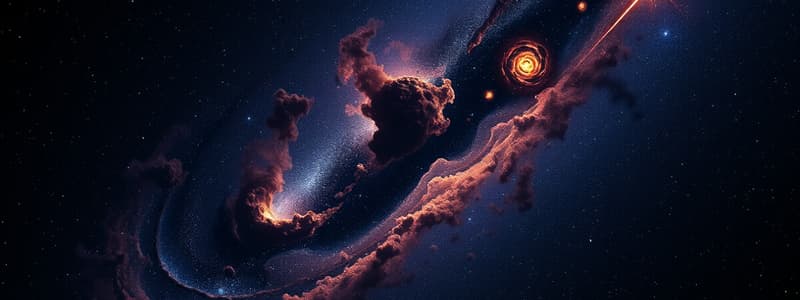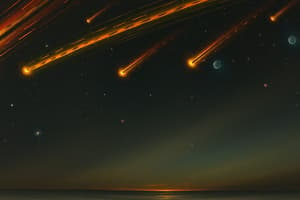Podcast
Questions and Answers
Which of the following statements about comets is NOT true?
Which of the following statements about comets is NOT true?
- Comets can be observed from Earth without a telescope.
- Comets are made primarily of ice and dust.
- Comets always exhibit a bright tail when close to the Sun.
- Comets originate from the asteroid belt. (correct)
What distinguishes meteors from asteroids?
What distinguishes meteors from asteroids?
- Meteors are meteoroids that have entered Earth's atmosphere. (correct)
- Meteors are larger than asteroids.
- Meteors originate primarily from asteroid belts.
- Asteroids usually have a tail, while meteors do not.
Which of the following best describes the composition of asteroids?
Which of the following best describes the composition of asteroids?
- Asteroids are primarily composed of ice and organic compounds.
- Asteroids are composed entirely of liquid substances.
- Asteroids are predominantly gaseous in nature.
- Asteroids mainly consist of metals and rocky materials. (correct)
What is the largest known asteroid in the asteroid belt?
What is the largest known asteroid in the asteroid belt?
Which feature is unique to comets compared to asteroids?
Which feature is unique to comets compared to asteroids?
Flashcards are hidden until you start studying
Study Notes
Comets
- Comets are icy bodies that, when close to the Sun, heat up and release gases, forming visible atmospheres called comas and sometimes tails.
- Comets originated from the outer regions of the solar system, particularly the Kuiper Belt and Oort Cloud.
Meteors
- Meteors are the streaks of light produced when meteoroids enter the Earth's atmosphere and burn up due to friction.
- If a meteoroid survives its passage through the atmosphere and lands on Earth, it is classified as a meteorite.
Asteroids
- Asteroids are rocky bodies that orbit the Sun, primarily found in the asteroid belt between Mars and Jupiter.
- The largest asteroid is Ceres, which is also classified as a dwarf planet with a diameter of approximately 940 kilometers.
Composition of Asteroids
- Asteroids are composed mainly of rock and metal, with some containing organic compounds and water ice.
- Their composition reflects the conditions of the early solar system, providing insights into planetary formation.
Studying That Suits You
Use AI to generate personalized quizzes and flashcards to suit your learning preferences.




